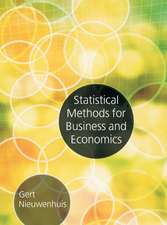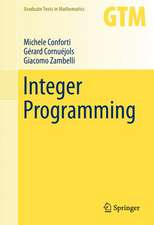Hamiltonian Cycle Problem and Markov Chains: International Series in Operations Research & Management Science, cartea 171
Autor Vivek S. Borkar, Vladimir Ejov, Jerzy A. Filar, Giang T. Nguyenen Limba Engleză Paperback – 8 mai 2014
The above innovative approach has now evolved to the point where there are many, both theoretical and algorithmic, results that exploit the nexus between graph theoretic structures and both probabilistic and algebraic entities of related Markov chains. The latter include moments of first return times, limiting frequencies of visits to nodes, or the spectra of certain matrices traditionally associated with the analysis of Markov chains. However, these results and algorithms are dispersed over many research papers appearing in journals catering to disparate audiences. As a result, the published manuscripts are often written in a very terse manner and use disparate notation, thereby making it difficult for new researchers to make use of the many reported advances.
Hence the main purpose of this book is to present a concise and yet easily accessible synthesis of the majority of the theoretical and algorithmicresults obtained so far. In addition, the book discusses numerous open questions and problems that arise from this body of work and which are yet to be fully solved. The approach casts the Hamiltonian Cycle Problem in a mathematical framework that permits analytical concepts and techniques, not used hitherto in this context, to be brought to bear to further clarify both the underlying difficulty of NP-completeness of this problem and the relative exceptionality of truly difficult instances. Finally, the material is arranged in such a manner that the introductory chapters require very little mathematical background and discuss instances of graphs with interesting structures that motivated a lot of the research in this topic. More difficult results are introduced later and are illustrated with numerous examples.
| Toate formatele și edițiile | Preț | Express |
|---|---|---|
| Paperback (1) | 636.45 lei 6-8 săpt. | |
| Springer – 8 mai 2014 | 636.45 lei 6-8 săpt. | |
| Hardback (1) | 640.88 lei 6-8 săpt. | |
| Springer – 24 apr 2012 | 640.88 lei 6-8 săpt. |
Din seria International Series in Operations Research & Management Science
- 20%
 Preț: 331.25 lei
Preț: 331.25 lei - 20%
 Preț: 570.61 lei
Preț: 570.61 lei - 18%
 Preț: 1132.02 lei
Preț: 1132.02 lei - 18%
 Preț: 773.72 lei
Preț: 773.72 lei -
 Preț: 170.39 lei
Preț: 170.39 lei - 17%
 Preț: 459.34 lei
Preț: 459.34 lei - 17%
 Preț: 360.47 lei
Preț: 360.47 lei -
 Preț: 263.40 lei
Preț: 263.40 lei - 24%
 Preț: 905.30 lei
Preț: 905.30 lei - 17%
 Preț: 460.08 lei
Preț: 460.08 lei - 17%
 Preț: 459.34 lei
Preț: 459.34 lei - 20%
 Preț: 631.58 lei
Preț: 631.58 lei - 13%
 Preț: 480.00 lei
Preț: 480.00 lei - 18%
 Preț: 738.28 lei
Preț: 738.28 lei - 18%
 Preț: 1225.94 lei
Preț: 1225.94 lei - 18%
 Preț: 948.92 lei
Preț: 948.92 lei - 18%
 Preț: 703.88 lei
Preț: 703.88 lei - 18%
 Preț: 957.44 lei
Preț: 957.44 lei - 15%
 Preț: 651.84 lei
Preț: 651.84 lei - 20%
 Preț: 336.21 lei
Preț: 336.21 lei - 15%
 Preț: 641.03 lei
Preț: 641.03 lei -
 Preț: 404.29 lei
Preț: 404.29 lei - 18%
 Preț: 950.21 lei
Preț: 950.21 lei - 15%
 Preț: 649.06 lei
Preț: 649.06 lei - 18%
 Preț: 725.75 lei
Preț: 725.75 lei -
 Preț: 394.12 lei
Preț: 394.12 lei - 18%
 Preț: 951.47 lei
Preț: 951.47 lei - 15%
 Preț: 639.59 lei
Preț: 639.59 lei - 18%
 Preț: 773.06 lei
Preț: 773.06 lei - 18%
 Preț: 889.29 lei
Preț: 889.29 lei - 15%
 Preț: 655.60 lei
Preț: 655.60 lei - 15%
 Preț: 640.06 lei
Preț: 640.06 lei - 15%
 Preț: 583.93 lei
Preț: 583.93 lei
Preț: 636.45 lei
Preț vechi: 748.76 lei
-15% Nou
Puncte Express: 955
Preț estimativ în valută:
121.78€ • 126.90$ • 100.84£
121.78€ • 126.90$ • 100.84£
Carte tipărită la comandă
Livrare economică 03-17 aprilie
Preluare comenzi: 021 569.72.76
Specificații
ISBN-13: 9781489992277
ISBN-10: 1489992278
Pagini: 216
Ilustrații: XIV, 202 p.
Dimensiuni: 155 x 235 x 11 mm
Greutate: 0.31 kg
Ediția:2012
Editura: Springer
Colecția Springer
Seria International Series in Operations Research & Management Science
Locul publicării:New York, NY, United States
ISBN-10: 1489992278
Pagini: 216
Ilustrații: XIV, 202 p.
Dimensiuni: 155 x 235 x 11 mm
Greutate: 0.31 kg
Ediția:2012
Editura: Springer
Colecția Springer
Seria International Series in Operations Research & Management Science
Locul publicării:New York, NY, United States
Public țintă
Professional/practitionerCuprins
Illustrative Graphs.- Intriguing Properties.- Markov Chains.- Markov Decision Processes.- Determinants.- Traces.- Linear Programming Based Algorithms.- Interior Point and Cross-Entropy Algorithms.- Self-similar Structure and Hamiltonicity.- Graph Enumeration.
Textul de pe ultima copertă
This research monograph summarizes a line of research that maps certain classical problems of discrete mathematics and operations research - such as the Hamiltonian cycle and the Travelling Salesman problems – into convex domains where continuum analysis can be carried out. Arguably, the inherent difficulty of these, now classical, problems stems precisely from the discrete nature of domains in which these problems are posed. The convexification of domains underpinning the reported results is achieved by assigning probabilistic interpretation to key elements of the original deterministic problems. In particular, approaches summarized here build on a technique that embeds Hamiltonian Cycle and Traveling Salesman problems in a structured singularly perturbed Markov decision process. The unifying idea is to interpret subgraphs traced out by deterministic policies (including Hamiltonian cycles, if any) as extreme points of a convex polyhedron in a space filled with randomized policies.
The above, innovative, approach has now evolved to the point where there are many, both theoretical and algorithmic, results that exploit the nexus between graph theoretic structures and both probabilistic and algebraic entities of related Markov chains. The latter include moments of first return times, limiting frequencies of visits to nodes, or the spectra of certain matrices traditionally associated with the analysis of Markov chains. However, these results and algorithms are dispersed over more than fifteen research papers appearing in journals catering to disparate audiences such as: MOR, Random Structures and Algorithms, SIAM J. on Discrete Mathematics, Optimization, J. of Mathematical Analysis and Applications and some others. Furthermore, because of the evolution of this topic and specific orientation of these journals, the published manuscripts are often written in a very terse manner and use disparate notation. As such it is difficult for newresearchers to make use of the many advances reported in these papers.
Hence the main purpose of this book is to present a concise and yet, well written, synthesis of the majority of the theoretical and algorithmic results obtained so far. In addition the book will discuss numerous open questions and problems that arise from this body of work and which are yet to be fully solved. The authors believe that their approach casts the Hamiltonian Cycle and Traveling Salesman problems in a mathematical framework that permits analytical concepts and techniques, not used hitherto in their context, to be brought to bear to further clarify both the underlying difficulty of NP-completeness of these problems and the relative exceptionality of truly difficult instances.
Finally, the material is arranged in such a manner that the introductory chapters require very little mathematical background and discuss instances of graphs with interesting structures that motivated a lot of the research in this topic. More difficult results are introduced later but, unlike the research manuscripts where they were originally proved, are illustrated with numerous examples.
The above, innovative, approach has now evolved to the point where there are many, both theoretical and algorithmic, results that exploit the nexus between graph theoretic structures and both probabilistic and algebraic entities of related Markov chains. The latter include moments of first return times, limiting frequencies of visits to nodes, or the spectra of certain matrices traditionally associated with the analysis of Markov chains. However, these results and algorithms are dispersed over more than fifteen research papers appearing in journals catering to disparate audiences such as: MOR, Random Structures and Algorithms, SIAM J. on Discrete Mathematics, Optimization, J. of Mathematical Analysis and Applications and some others. Furthermore, because of the evolution of this topic and specific orientation of these journals, the published manuscripts are often written in a very terse manner and use disparate notation. As such it is difficult for newresearchers to make use of the many advances reported in these papers.
Hence the main purpose of this book is to present a concise and yet, well written, synthesis of the majority of the theoretical and algorithmic results obtained so far. In addition the book will discuss numerous open questions and problems that arise from this body of work and which are yet to be fully solved. The authors believe that their approach casts the Hamiltonian Cycle and Traveling Salesman problems in a mathematical framework that permits analytical concepts and techniques, not used hitherto in their context, to be brought to bear to further clarify both the underlying difficulty of NP-completeness of these problems and the relative exceptionality of truly difficult instances.
Finally, the material is arranged in such a manner that the introductory chapters require very little mathematical background and discuss instances of graphs with interesting structures that motivated a lot of the research in this topic. More difficult results are introduced later but, unlike the research manuscripts where they were originally proved, are illustrated with numerous examples.
Caracteristici
Concise, readable synthesis of important yet scattered research to date Discusses problems yet to be fully solved Provides many examples not supplied in original studies Includes supplementary material: sn.pub/extras











